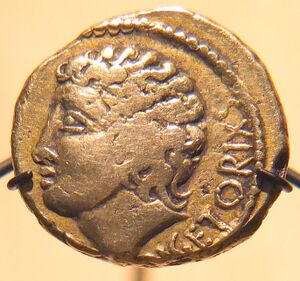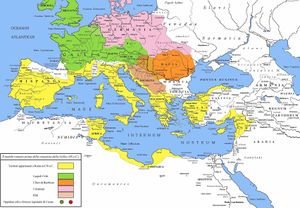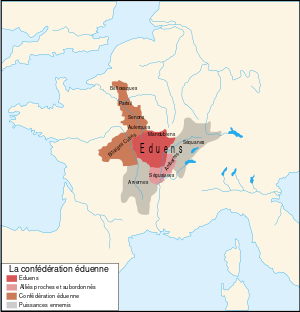ڤرسانجتوريكس
ڤرسانجتوريكس | |
|---|---|
Vercingetorix | |
 | |
| ملك وزعيم قبيلة أرڤرني | |
| تفاصيل شخصية | |
| وُلِد | 82 ق.م. غير معروف |
| توفي | 46 ق.م. (36–37 سنة) روما، الجمهورية الرومانية، إيطاليا |
| سبب الوفاة | الإعدام بالخنق |
ڤرسانگتوريكس (إنگليزية: Vercingetorix؛ /ˌvɜrsɪnˈdʒɛtərɪks/ VUR-sin-JET-ə-riks أو /ˌvɜrsɪŋˈɡɛtərɪks/ VUR-sing-GET-ə-riks؛ نطق اللاتينية: [werkiŋˈɡetoriːks]؛ ح. 82 ق.م. – 46 ق.م.)، هو ملك وزعيم قبيلة أرڤرني؛ وحد الغال في ثورة ضد القوات الرومانية في المرحلة الأولى من الحروب الغالية التي شنها يوليوس قيصر. على الرغم من استسلامه طواعية لقيصر، فقد سـُجن لستة أعوام في روما، ثم أُعدِم.
ڤرسانگتوريكس هو ابن سلتيوس الأرڤرني، زعيم قبائل الگال. وصل ڤرسانگتوريكس إلى السلطة بعد تعيينه رسميًا كزعيم لقبيلة أرڤرني في أوپيدوم گرگوڤيا عام 52 ق.م. أسس على الفور تحالفًا مع قبائل الگل الأخرى، وتولى القيادة، ودمج جميع القوات وقادهم في أهم ثورة الكلتيين ضد القوات الرومانية. انتصر في معركة گرگوڤيا ضد يوليوس قيصر حيث قتل عدة آلاف من الرومان وحلفائهم وانسحبت الجحافل الرومانية.
كان يوليوس قيصر قادرًا على استغلال الانقسامات الداخلية الغالية لإخضاع البلاد بسهولة، وجاءت محاولة ڤرسانگتوريكس لتوحيد الإغريق ضد الغزو الروماني بعد فوات الأوان.[2][3]
في معركة ألسيا، عام 52 أيضاً، حوصر الرومان وهُزمت قواتهم؛ لإنقاذ أكبر عدد ممكن من رجاله، سلم نفسه للرومان. احتجز لخمس سنوات. عام 46 ق.م، كجزء من انتصار يوليوس قيصر، عُرض في شوارع روما ثم تم إعدامه بكسر العنق. عُرف ڤرسانجتوريكس بشكل أساسي من خلال "تعليقات على حرب الگال" Commentarii de Bello Gallico ليوليوس قيصر. حتى يومنا هذا، يعتبر ڤرسانجتوريكس بطلاً شعبياً في أوڤرن، مسقط رأسه.
. . . . . . . . . . . . . . . . . . . . . . . . . . . . . . . . . . . . . . . . . . . . . . . . . . . . . . . . . . . . . . . . . . . . . . . . . . . . . . . . . . . . . . . . . . . . . . . . . . . . . . . . . . . . . . . . . . . . . . . . . . . . . . . . . . . . . . . . . . . . . . . . . . . . . . . . . . . . . . . . . . . . . . . .
الاسم
اسم ڤرسانجتوريكس، مشتق من الكلمة الگالية ver- ("فوق، أعلى" – الاصل الاشتقاقي للكلمة الكورنية gor-، الأيرندية إلى-، المعنى الأبعد للكلمة الإنگليزية فوق، بالألمانية über، باللاتينية الأعلى، أو اليونانية hyper),[4] cingeto- ("المحارب"، المرتبطة بالمعنى الأصلي" الخطوة، المشية "، أو ربما "جندي المشاة"؛ مقارنة بالكلمة الأيرلندية القديمة cingid)،[5][4] أو rix ("الملك") (cf. بالويلزية rhi، اللاتينية rex)، بالتالي، فالمعنى الحرفي هو "الملك المحارب العظيم" أو "ملك المحاربين العظام".[5][4][6][7]
التاريخ
Having been appointed governor of the Roman province of Gallia Narbonensis (modern Provence) in 58 BC, Julius Caesar proceeded to conquer the Gallic tribes beyond over the next few years, maintaining control through a careful divide and rule strategy. He made use of the factionalism among the Gallic elites, favouring certain noblemen over others with political support and Roman luxuries such as wine. Attempts at revolt, such as that of Ambiorix in 54 BC, had secured only local support, but Vercingetorix, whose father, Celtillus, had been put to death by his own countrymen for seeking to rule all of Gaul, managed to unify the Gallic tribes against the Romans and adopted more current styles of warfare.
Averni nobleman
The revolt that Vercingetorix came to lead began in early 52 BC while Caesar was raising troops in Cisalpine Gaul. Believing that Caesar would be distracted by the turmoil in Rome following the death of Publius Clodius Pulcher, the Carnutes, under Cotuatus and Conetodunus, made the first move, slaughtering the Romans who had settled in their territory.
Vercingetorix, a young nobleman of the Arvernian city of Gergovia, roused his dependents to join the revolt, but he and his followers were expelled by Vercingetorix's uncle Gobanitio and the rest of the nobles because they thought that opposing Caesar was too great a risk. Undeterred, Vercingetorix raised an army of the poor, took Gergovia, and was hailed as king.[8]
Tribal alliances
He made alliances with other tribes, and in doing so he united Gaul under the pretense of escaping Roman rule. After having been unanimously given supreme command of their armies, he imposed his authority through harsh discipline and the taking of hostages. Leadership and unification on this level was unprecedented in Gaul and would not happen again for decades.
He adopted a policy of retreating to natural fortifications, and undertook an early example of a scorched earth strategy by burning towns to prevent the Roman legions from living off the land.[9] Vercingetorix scorched much of the land marching north with his army from Gergovia in an attempt to deprive Caesar of the resources and safe haven of the towns and villages along Caesar's march south.
Siege of Avaricum
However, the capital of the Bituriges, Avaricum (near modern-day Bourges), a Gallic settlement directly in Caesar's path, was spared. Due to the town's strong protests, naturally defensible terrain, and apparently strong man-made reinforcing defenses, Vercingetorix decided against razing and burning it. Leaving the town to its fate, Vercingetorix camped well outside of Avaricum and focused on conducting harassing engagements of the advancing Roman units led by Caesar and his chief lieutenant Titus Labienus. Upon reaching Avaricum, however, the Romans laid siege and eventually captured the capital.
Afterwards, in a reprisal for 25 days of hunger and of laboring over the siegeworks required to breach Avaricum's defenses, the Romans slaughtered nearly the entire population, some 40,000 people, leaving only about 800 alive.[10]
معركة گرگوڤيا
The next major battle was at Gergovia, capital city of the Arverni. During the battle, Vercingetorix and his warriors crushed Caesar's legions and allies, inflicting heavy losses. Vercingetorix then decided to follow Caesar but suffered heavy losses (as did the Romans and their allies[11]) during a cavalry battle and he retreated and moved to another stronghold, Alesia.
معركة ألسيا
 مقالة مفصلة: معركة ألسيا
مقالة مفصلة: معركة ألسيا
في معركة ألسيا في سبتمبر 52 ق.م، بنى يوليوس قيصر تحصين حول المدينة لمحاصرتها. ومع ذلك، استدعى ڤرسانجتوريكس حلفاءه من الگال لمهاجمة الرومان المحاصرين. تضمنت هذه القوات جيشًا من أرڤرني بقيادة ڤركاسيڤلونوس ابن عم ڤرسانجتوريكس وجيشًا قوامه 10.000 لموڤيكس بقيادة سدولوس.
مع التطويق الروماني المحاط ببقية بلاد الگال، بنى يوليوس قيصر حصنًا آخر مواجهًا للخارج ضد جيوش الإغاثة المتوقعة، مما أدى إلى تحصين على شكل قطعة دونات. جاءت الإغاثة الگالية بأعداد غير كافية: تتراوح التقديرات من 80.000 إلى 250.000 جندي. ڤرسانجتوريكس، زعيم التكتيك، عُزل عن القوات في الداخل، وبدون توجيهه لم تنجح الهجمات في البداية. إلا أن الهجمات كشفت عن نقطة ضعف في التحصينات وكادت القوات المشتركة في الداخل والخارج أن تحقق اختراقًا. فقط عندما قاد قيصر شخصيًا آخر الاحتياطيات في المعركة، تمكن أخيرًا من الانتصار. كانت هذه معركة حاسمة في تأسيس الإمبراطورية الرومانية.
بحسب پلوتارخ، "كايس". 27.8-10، استسلم ڤرسانجتوريكس بطريقة مأساوية، راكبًا حصانه المزين بشكل جميل خارج ألسيا وحول معسكر قيصر قبل أن ينزل أمام قيصر، متجردًا من درعه وجلس عند أقدام خصمه، حيث ظل ساكنًا بلا حراك حتى تم اقتياده.[12][13] يقدم قيصر تناقضًا مباشرًا لهذه الرواية دي بيل، گال. 7.89، حيث يصف استسلام ڤرسانجتوريكس بشكل أكثر تواضعًا.[14]
سجنه ووفاته

سُجن ڤرسانجتوريكس في التوليانوم في روما لما يقرب من ست سنوات قبل أن يتم عرضه علنًا في أول أربعة من انتصارات يوليوس قيصر عام 46 ق.م. أُعدم بكسر العنق في بشكل احتفالي في معبد جوپيتر أوپتيموس ماكسيموس بعد الانتصار. [15] تشير لوحة في التوليانوم إلى قطع رأسه عام 49 ق.م.
. . . . . . . . . . . . . . . . . . . . . . . . . . . . . . . . . . . . . . . . . . . . . . . . . . . . . . . . . . . . . . . . . . . . . . . . . . . . . . . . . . . . . . . . . . . . . . . . . . . . . . . . . . . . . . . . . . . . . . . . . . . . . . . . . . . . . . . . . . . . . . . . . . . . . . . . . . . . . . . . . . . . . . . .
ذكراه
نصب تذكارية
Napoleon III erected a 7-metre-tall (23 ft) Vercingétorix monument in 1865, created by the sculptor Aimé Millet, on the supposed site of Alesia. The architect for the memorial was Eugène Viollet-le-Duc.[16] The statue still stands. The inscription on the base, written by Viollet-le-Duc, which copied the famous statement of Julius Caesar, reads (in French):
La Gaule unie |
Gaul united, |
Many other monumental statues of Vercingetorix were erected in France during the 19th century, including one by Frédéric Bartholdi on the Place de Jaude in Clermont-Ferrand.[17]
مذنب
Asteroid 52963 Vercingetorix, discovered by the OCA–DLR Asteroid Survey, was named in his honor.[18] The official naming citation was published by the Minor Planet Center on 25 September 2018 (M.P.C. 111800).[19]
كرتون
Vercingetorix is referenced and appears in flashbacks in several Asterix comics. Asterix and the Chieftain's Shield is about Asterix and Obelix's efforts to locate Vercingetorix's missing shield and humiliate Caesar in the process.
He is the co-protagonist and title character of the 18th book in the series The Adventures of Alix.
تلفزيون
The 2005–2007 HBO series Rome depicts the surrender and execution of Vercingetorix.
أفلام
The 2001 film Druids, starring Christopher Lambert as Vercingetorix, depicts the Gaul Chieftain's struggle against Caesar. The film is infamous in France for its poor quality and dismal box office performance. The script was written by Norman Spinrad, who also authored the novelization The Druid King.
انظر أيضاً
الهوامش
- ^ Bakker, Marco. "Reportret: Vercingetorix". www.reportret.info. Retrieved 1 April 2018.
- ^ "France: The Roman conquest". Encyclopædia Britannica Online. Encyclopædia Britannica. Retrieved April 6, 2015.
Because of chronic internal rivalries, Gallic resistance was easily broken, though Vercingetorix's Great Rebellion of 52 BC had notable successes.
- ^ "Julius Caesar: The first triumvirate and the conquest of Gaul". Encyclopædia Britannica Online. Encyclopædia Britannica. Retrieved February 15, 2015.
Indeed, the Gallic cavalry was probably superior to the Roman, horseman for horseman. Rome's military superiority lay in its mastery of strategy, tactics, discipline, and military engineering. In Gaul, Rome also had the advantage of being able to deal separately with dozens of relatively small, independent, and uncooperative states. Caesar conquered these piecemeal, and the concerted attempt made by a number of them in 52 BC to shake off the Roman yoke came too late.
- ^ أ ب ت Matasović 2017, p. 398.
- ^ أ ب Matasović 2017, p. 200.
- ^ Evans, D. Ellis (1967). Gaulish personal names: a study of some Continental Celtic formations (in الإنجليزية). Clarendon P. pp. 121 & 122.
- ^ X., Delamarre (2003). Dictionnaire de la langue gauloise : une approche linguistique du vieux-celtique continental (2e éd. rev. et augm ed.). Paris: Errance. p. 314. ISBN 9782877723695. OCLC 354152038.
- ^ Julius Caesar, Commentaries on the Gallic War Book VII, sect. 4.
- ^ "Vercingetorix". penelope.uchicago.edu. Retrieved 2022-11-12.
- ^ Julius Caesar, Commentaries on the Gallic War vii.
- ^ "The Internet Classics Archive | Caesar by Plutarch". classics.mit.edu. Retrieved 2021-03-31.
- ^ Plutarch's Lives; Caes. 27.8-10; Flor. 1.45.26; Dio 40.41.3. Medieval French Historians are also partly responsible for romanticising Vercingetorix's surrender. Romancing the Past: The Rise of Vernacular Prose Historiography in Thirteenth-Century France, by Gabrielle M. Spiegel, page 143, Berkeley: 1993.
- ^ Plutarch. "The Life of Julius Caesar". The Parallel Lives. Loeb Classical Library Edition. Retrieved 15 July 2015.
- ^ Commentaries on the Gallic Wars, Everyman's Edition, 1953 (Trans: John Warrington); Book VII, sect. 89.
- ^ Dio 40.41.3، 43.19.4
- ^ Statue of Vercingetorix Archived 2007-03-10 at the Wayback Machine, Art and Architecture, 2006
- ^ Dietler, Michael, "Our ancestors the Gauls": archaeology, ethnic nationalism, and the manipulation of Celtic identity in modern Europe Archived 2016-03-04 at the Wayback Machine (7.3M), American Anthropologist, 1994, 96: 584–605. Dietler, M., A tale of three sites: the monumentalization of Celtic oppida and the politics of collective memory and identity, World Archaeology, 1998, 30: 72–89.
- ^ خطأ استشهاد: وسم
<ref>غير صحيح؛ لا نص تم توفيره للمراجع المسماةMPC-object - ^ خطأ استشهاد: وسم
<ref>غير صحيح؛ لا نص تم توفيره للمراجع المسماةMPC-Circulars-Archive
المصادر
مراجع أساسية
- Julius Caesar, Commentarii de Bello Gallico Book 7
- Dio Cassius, Roman History 40:33-41, 43:19
- Plutarch, Life of Caesar 25-27
وصلات خارجية
- A reconstructed portrait of Vercingetorix, based on historical sources, in a contemporary style.
- Curchin, Leonard A. Lingua Gallica (The Gaulish Language). Retrieved January 23, 2010 from Uwaterloo.ca
- Paul Marius Martin, Vercingétorix : le politique, le stratège. Paris : Perrin, 2000, 260 p. ISBN 2-262-01691-7.
- Articles containing إنگليزية-language text
- Pages using Lang-xx templates
- Articles containing لاتينية-language text
- المقالات needing additional references from September 2022
- كل المقالات needing additional references
- مواليد عقد 80 ق.م.
- وفيات 46 ق.م.
- حكام أوروپيون من القرن الأول ق.م.
- حكام غاليون
- برابرة في الحروب الگالية
- أشخاص أعدمتهم الجمهورية الرومانية
- سنة الميلاد غير معروفة
- اعدامات القرن الأول ق.م.
- وفيات عقد 40 ق.م.






